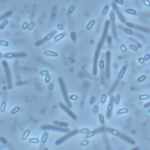Link to Pubmed [PMID] – 27652799
Virulence 2017 Aug;8(6):767-781
Clostridium difficile is a major cause of antibiotic induced diarrhea worldwide, responsible for significant annual mortalities and represents a considerable economic burden on healthcare systems. The two main C. difficile virulence factors are toxins A and B. Isogenic toxin B mutants of 2 independently isolated erythromycin-sensitive derivatives (630E and 630Δerm) of strain 630 were previously shown to exhibit substantively different phenotypes. Compared to 630, strain 630E and its progeny grow slower, achieve lower final cell densities, exhibit a reduced capacity for spore-formation, produce lower levels of toxin and are less virulent in the hamster infection model. By the same measures, strain 630Δerm and its derivatives more closely mirror the behavior of 630. Genome sequencing revealed that 630Δerm had acquired 7 unique Single Nucleotide Polymorphisms (SNPs) compared to 630 and 630E, while 630E had 9 SNPs and a DNA inversion not found in the other 2 strains. The relatively large number of mutations meant that the identification of those responsible for the altered properties of 630E was not possible, despite the restoration of 3 mutations to wildtype by allelic exchange and comparative RNAseq analysis of all 3 strains. The latter analysis revealed large differences in gene expression between the 3 strains, explaining in part why no single SNP could restore the phenotypic differences. Our findings suggest that strain 630Δerm should be favored over 630E as a surrogate for 630 in genetic-based studies. They also underline the importance of effective strain curation and the need to genome re-sequence master seed banks wherever possible.


